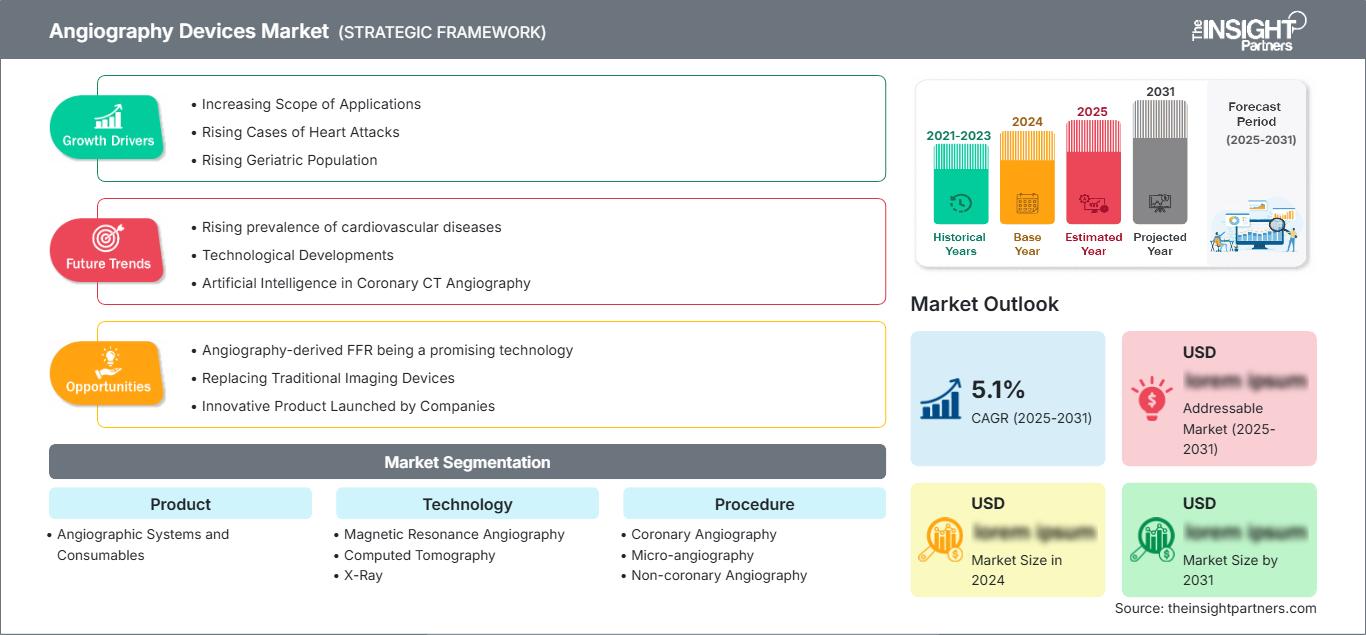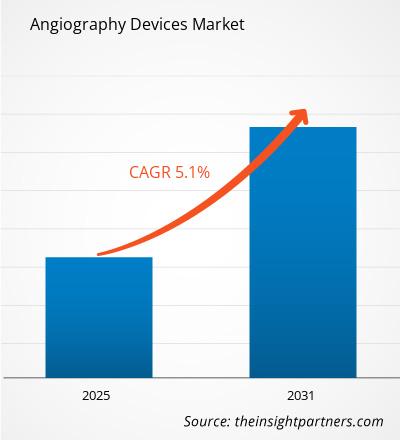Se espera que el mercado de dispositivos de angiografía alcance los 19.240 millones de dólares estadounidenses para 2031. Se prevé que registre una tasa de crecimiento anual compuesta (TCAC) del 5,8 % entre 2025 y 2031.
El informe está segmentado por mercado de dispositivos de angiografía por producto (sistemas angiográficos y consumibles), tecnología [angiografía por resonancia magnética (ARM), tomografía computarizada (TC), rayos X y otras tecnologías)], procedimiento (angiografía coronaria, microangiografía, angiografía no coronaria y otras), aplicación (diagnóstica y terapéutica), indicación (cardiopatía congénita, insuficiencia cardíaca congestiva, cardiopatía valvular, enfermedad arterial coronaria conocida y sospechada (EAC) y otras), usuario final (hospitales, centros de diagnóstico, centros quirúrgicos ambulatorios y laboratorios de investigación académica) y geografía (América del Norte, Europa, Asia Pacífico, Oriente Medio y África, y América del Sur y Central). El análisis global se desglosa aún más a nivel regional y por países principales. El informe ofrece el valor en USD para el análisis y los segmentos anteriores.
Propósito del Informe
El informe "Mercado de Dispositivos de Angiografía" de The Insight Partners busca describir el panorama actual y el crecimiento futuro, los principales factores impulsores, los desafíos y las oportunidades. Esto proporcionará información a diversas partes interesadas del negocio, como:
- Proveedores/fabricantes de tecnología: Para comprender la dinámica cambiante del mercado y conocer las oportunidades potenciales de crecimiento, lo que les permitirá tomar decisiones estratégicas informadas.
- Inversores: Realizar un análisis exhaustivo de tendencias respecto a la tasa de crecimiento del mercado, las proyecciones financieras del mercado y las oportunidades que existen en toda la cadena de valor.
- Órganos reguladores: Regular las políticas y las actividades policiales en el mercado con el objetivo de minimizar el abuso, preservar la confianza de los inversores y defender la integridad y estabilidad del mercado.
Segmentación del mercado de dispositivos de angiografía Producto
- Sistemas angiográficos y consumibles
Tecnología
- Angiografía por resonancia magnética
- Tomografía computarizada
- Radiografía
- Otras tecnologías
Procedimiento
- Angiografía coronaria
- Microangiografía
- Angiografía no coronaria
- Otros
Solicitud
- Diagnóstico
- Terapéutico
Indicación
- Enfermedad cardíaca congénita
- Insuficiencia cardíaca congestiva
- Enfermedad cardíaca valvular
- Enfermedad coronaria conocida y sospechada
Obtendrá personalización en cualquier informe, sin cargo, incluidas partes de este informe o análisis a nivel de país, paquete de datos de Excel, así como también grandes ofertas y descuentos para empresas emergentes y universidades.
Mercado de dispositivos de angiografía: Perspectivas estratégicas

- Obtenga las principales tendencias clave del mercado de este informe.Esta muestra GRATUITA incluirá análisis de datos, desde tendencias del mercado hasta estimaciones y pronósticos.
Factores que impulsan el crecimiento del mercado de dispositivos de angiografía
- Ampliación del alcance de aplicaciones: Los dispositivos de angiografía se utilizan para comprobar la salud de los vasos sanguíneos y el flujo sanguíneo a través de ellos. Pueden ayudar a diagnosticar o investigar diversos problemas que afectan a los vasos sanguíneos, como la aterosclerosis (estrechamiento de las arterias). Facilitan intervenciones quirúrgicas mínimamente invasivas complejas y delicadas.
- Aumento de casos de infartos: Es probable que el aumento de la prevalencia de infartos impulse el crecimiento del mercado. Según los Centros para el Control y la Prevención de Enfermedades (CDC), aproximadamente cada 40 segundos un estadounidense sufre un infarto. Cada año, 805.000 estadounidenses sufren un infarto, 605.000 de ellos por primera vez. Alrededor del 12% de las personas que sufren un infarto fallecen a causa de él.
- Aumento de la población geriátrica: Se estimó que la población de 60 años o más era de 1.000 millones en 2020. Para 2050, la población mundial de personas de 60 años o más se duplicará (2.100 millones). Se prevé que el número de personas de 80 años o más se triplique entre 2020 y 2050, alcanzando los 426 millones.
Tendencias futuras del mercado de dispositivos de angiografía
- Aumento de la prevalencia de enfermedades cardiovasculares: el número anual de muertes por enfermedades cardiovasculares (ECV) en la India ha aumentado de 2,26 millones (1990) a 4,77 millones en 2020. Las tasas de prevalencia de enfermedades coronarias en la India se han estimado en las últimas décadas y han oscilado entre el 1,6% y el 7,4% en las poblaciones rurales y entre el 1% y el 13,2% en las poblaciones urbanas en 2023.
- Desarrollos tecnológicos: La angiografía por tomografía computarizada (TC) es una tecnología innovadora que se utiliza como alternativa a las pruebas de esfuerzo. La angiografía coronaria por TC es una prueba diagnóstica no invasiva que permite determinar la presencia, cantidad y gravedad de la placa aterosclerótica en las arterias cardíacas. El equipo esencial necesario para la angiografía convencional incluye: un conjunto de catéteres y guías.
- Inteligencia Artificial en Angiografía Coronaria por TC: La cardiopatía coronaria (CC) es la principal causa de mortalidad en el mundo. Su detección y tratamiento tempranos son cruciales. Actualmente, la angiografía coronaria por TC (ACTC) ha sido la opción preferida para el cribado y diagnóstico de la CC, pero no satisface las necesidades clínicas en cuanto a la calidad del examen, la precisión de los informes y la precisión del análisis pronóstico. En los últimos años, la inteligencia artificial (IA) ha evolucionado rápidamente en el campo de la medicina; ha desempeñado un papel clave en el diagnóstico auxiliar, el análisis de los mecanismos de la enfermedad y la evaluación del pronóstico, incluyendo una serie de estudios relacionados con la CC.
Oportunidades de mercado para dispositivos de angiografía
- La FFR derivada de la angiografía es una tecnología prometedora: La FFR derivada de la angiografía se ha consolidado como una tecnología prometedora en el campo de la cardiología intervencionista. Gracias a los avances en algoritmos de software y técnicas de procesamiento de imágenes, se han logrado avances significativos en la precisión y reproducibilidad de las mediciones de FFR derivadas de imágenes angiográficas.
- Reemplazo de los dispositivos de imagen tradicionales: La angiografía ofrece numerosas ventajas, ya que permite obtener imágenes dinámicas en tiempo real mediante un dispositivo de imagen tradicional, como rayos X o tomografía computarizada (TC), y también ofrece opciones terapéuticas en el momento del diagnóstico inicial. Los avances en la tecnología de imagen en las últimas tres décadas han ampliado el alcance de la angiografía para incluir técnicas no invasivas mediante TC y resonancia magnética.
- Producto innovador lanzado por empresas: En abril de 2022, Shimadzu Corporation inició las ventas mundiales de su sistema de angiografía insignia Trinias. El nuevo sistema Trinias utiliza tecnología de aprendizaje profundo con IA para mejorar la visibilidad de los dispositivos médicos, utilizando una dosis de rayos X un 40 % menor que la de los modelos anteriores. Esta implementación de IA en el motor de procesamiento de imágenes de un sistema de angiografía ha sido un hito revolucionario para la empresa.
Perspectivas regionales del mercado de dispositivos de angiografía
Los analistas de The Insight Partners han explicado detalladamente las tendencias regionales y los factores que influyen en el mercado de dispositivos de angiografía durante el período de pronóstico. Esta sección también analiza los segmentos y la geografía del mercado de dispositivos de angiografía en América del Norte, Europa, Asia Pacífico, Oriente Medio y África, y América del Sur y Central.
Alcance del informe de mercado de dispositivos de angiografía
| Atributo del informe | Detalles |
|---|---|
| Tamaño del mercado en 2024 | XX mil millones de dólares estadounidenses |
| Tamaño del mercado en 2031 | US$ 19.24 mil millones |
| CAGR global (2025-2031) | 5,8% |
| Datos históricos | 2021-2023 |
| Período de pronóstico | 2025-2031 |
| Segmentos cubiertos | Por producto
|
| Regiones y países cubiertos | América del norte
|
| Líderes del mercado y perfiles de empresas clave |
|
Densidad de actores del mercado de dispositivos de angiografía: comprensión de su impacto en la dinámica empresarial
El mercado de dispositivos de angiografía está creciendo rápidamente, impulsado por la creciente demanda de los usuarios finales debido a factores como la evolución de las preferencias de los consumidores, los avances tecnológicos y un mayor conocimiento de los beneficios del producto. A medida que aumenta la demanda, las empresas amplían su oferta, innovan para satisfacer las necesidades de los consumidores y aprovechan las tendencias emergentes, lo que impulsa aún más el crecimiento del mercado.

- Obtenga una descripción general de los principales actores clave del mercado de dispositivos de angiografía
Puntos clave de venta
- Cobertura integral: el informe cubre exhaustivamente el análisis de productos, servicios, tipos y usuarios finales del mercado de dispositivos de angiografía, proporcionando un panorama holístico.
- Análisis de expertos: el informe se compila con base en el conocimiento profundo de expertos y analistas de la industria.
- Información actualizada: El informe asegura relevancia comercial debido a su cobertura de información reciente y tendencias de datos.
- Opciones de personalización: este informe se puede personalizar para satisfacer los requisitos específicos del cliente y adaptarse adecuadamente a las estrategias comerciales.
Por lo tanto, el informe de investigación sobre el mercado de dispositivos de angiografía puede ayudar a descifrar y comprender el panorama de la industria y sus perspectivas de crecimiento. Si bien existen algunas preocupaciones válidas, las ventajas generales de este informe suelen superar las desventajas.
- Análisis histórico (2 años), año base, pronóstico (7 años) con CAGR
- Análisis PEST y FODA
- Tamaño del mercado, valor/volumen: global, regional y nacional
- Industria y panorama competitivo
- Conjunto de datos de Excel
Informes recientes
Testimonios
Razón para comprar
- Toma de decisiones informada
- Comprensión de la dinámica del mercado
- Análisis competitivo
- Información sobre clientes
- Pronósticos del mercado
- Mitigación de riesgos
- Planificación estratégica
- Justificación de la inversión
- Identificación de mercados emergentes
- Mejora de las estrategias de marketing
- Impulso de la eficiencia operativa
- Alineación con las tendencias regulatorias




















 Obtenga una muestra gratuita para - Mercado de dispositivos de angiografía
Obtenga una muestra gratuita para - Mercado de dispositivos de angiografía